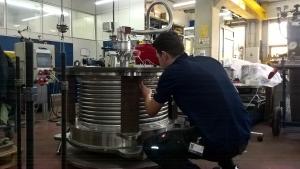Tokamak cooling system procurement
Global team for better efficiency
8 Jul 2019
-
ITER TCWS team and US ITER
A unique work-sharing arrangement is expediting the design and fabrication of ITER's tokamak cooling water system and building the knowledge base that will be critical to plant commissioning and operation.
Nearly 40 km of piping will be required by the ITER Tokamak's cooling water system. Fabrication is underway in the US and Germany, and deliveries have been arriving since 2017. Photo: Schulz/PCC
A joint TCWS Project Team—composed of staff from the ITER Organization and the US ITER Project Office—is making strong progress in the procurement of the tokamak cooling water system (TCWS). The hardware required for First Plasma is in production following design finalization in November 2017, and the design of second-phase components is advancing well.
The TCWS Project Team was established in late 2018 after US ITER and the ITER Organization agreed on several "arrangements" for improving the efficiency of system design and fabrication. "The overarching strategy is to get the job done on schedule, according to committed costs, while assuring quality in terms of function, safety, performance and installation consistency," says Sergio Orlandi, head of the Plant Engineering Department at ITER.
TCWS piping is in fabrication at Schulz XP USA/PCC Energy Group in Robinsonville, Mississippi, and at W. SCHULZ GmbH in Krefeld, Germany. The US facility is unique in its capability for producing large-bore piping extrusions, important given that some of the system piping is 600 mm in diameter. Other components, such as bellows to connect system piping to the cryostat, are in fabrication elsewhere in Europe.
Factory inspection of bellows at Witzenmann in Munich, Germany, before shipment to the ITER Organization. Photo: Witzenmann
"The Project Team establishes a pool of resources that are shared between the ITER Organization and US ITER. These specialists are working as one team, under a single framework, with the same objectives," says Donato Lioce, head of the ITER Tokamak Cooling Water System Design Section and TCWS Project Team Leader. Deputy Leader Duke Hughes, based in the US, agrees: "The implementation of the formal project team structure between US ITER and the ITER Organization creates a unique synergy that the TCWS team leverages to optimize the effectiveness and execution of its work."
Ultimately, nearly 40 km of piping will be manufactured for the TCWS. In addition, the system will require the fabrication of over 100 major industrial pieces of equipment operating with maximum temperatures of 400 °C and maximum pressures of 5 MPa or 50 bar.
To execute delivery of system hardware, the arrangements stipulate specific areas where the ITER Organization will be compensated to finalize design and procurement of hardware on behalf of US ITER. Because the cooling water system interfaces with most ITER plant systems and also has components that must comply with French nuclear pressure equipment directives (ESPN), design and fabrication is expedited by engaging ITER resources. This approach also prepares the ITER Organization, as nuclear operator, by building the knowledge to support commissioning and operation in future. US ITER retains responsibility for the system final design, manufacturing and delivery. The ITER Organization is responsible for on-site assembly, installation and commissioning.
The TCWS is designed to remove 1 GW of heat from ITER client systems, such as the first-wall/ blanket, vacuum vessel, divertor, and neutral beam injector. In addition, the system provides water chemistry control and draining/drying functions. The system interfaces with the secondary cooling water system, which is being provided by ITER India.



